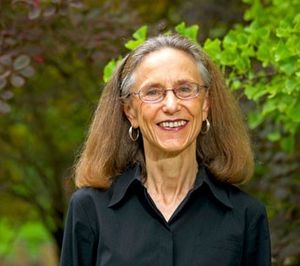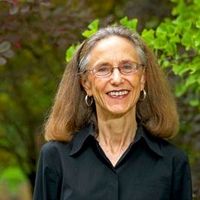Read about Cynthia in our faculty directory.
Spirituality x Environment
Amidst the mountains of tasks before me each day, I find it re-orienting to step back now and then to ask: “Just WHAT am I doing?” This pertains for us too as a body of people associated with the GTU. Just what is it that we are doing? At the GTU, we might agree that we are exploring and shaping theological education for the world of today and tomorrow.
If so, then it behooves us to ask anew, just what is the purpose of theological education in the early 2020s in western United States? From my perspective, it is to form people capable of hearing and heeding the sacred force, energy, or spirit that some call God, active in the world to bring us into our destiny — fullness of life for all in communion with the Sacred and with all of creation. The Black theologian, Willie James Jennings, puts it beautifully: theological education ought to be formation in the art of cultivating communion. “Communion,” he writes, is “what God wants.” Theological education ought to prepare people to call down, live into, and re-member the communion – both mystical and material — that God created and is creating.
Let us re-imagine this communion by giving thanks.
Slow down, breathe deep.
Notice: you are breathing and alive.
You would not be alive and breathing without a magnificent communion. The wild raucous communion of creatures within our bodies — trillions of them! — too tiny to see, scurrying about to keep us alive and well. Give thanks for it and for the communion beyond our skin:
- The thousands of organisms in a square foot of soil that grew the wheat, the oranges, and the coffee that I ate for breakfast to feed the trillions of organisms in my body.
- The communion of water molecules, including in our bodies, recycling themselves throughout time. (Are we not about 60 percent water by weight?)
- The trees of the Amazon serving as our external lungs.
Dr. John Chelladurai, Director of the India Peace Center in Nagpur, illumines as he writes:
The oxygen we consumed just now was released a while before by a plant close to us. Before it was released, that oxygen was part of the plant’s body. Now it is part of my body . . . .every day when we bathe, we remove a thin layer of our body –-- epithelial cells that are flushed out down the gutter. The cell that was ‘I’ travels through the gutter and reaches a canal or a pond in the outskirts, settles in the tank bed, disintegrates into amino-acids and sucrose, glucose, etc. Now ‘I’ am absorbed by the grass that grows on the banks, and the grass is now eaten by a cow, now the milk of that cow is sold in our neighborhood . . ..This way there is a definite passage of our individual body into different bodies around us. . . . we do not know how much of our body parts are exchanged with our neighbor with whom we are ill at ease.
Einstein said as much. “A human being is part of a whole, called by us the universe. . . He experiences himself, his thoughts and feelings, as something separate from the rest, a kind of optical delusion of his consciousness.”
Recently, one biblical text flooded me with wonder. “Ever since the creation of the world,” Paul writes to followers in Rome, “God has been “understood and seen through the things God has made.” What? God has been understood and seen for billions of years before our late-arriving species appeared on the scene? Who or what was understanding and seeing God then? This startling text suggests that the elements of this earth that existed eons before plants and animals came into being, have been “seeing and understanding” God.
What a staggering claim! Implications abound. For one, would it not be wise to listen and learn from the creatures and elements about what they have seen and understood of God? Might we glimpse more fully just who or what the Sacred lifeforce is that some call God?
For centuries Christians claimed that God provided two books of revelation: Creation itself and the Scriptures. How is it that we learn Greek and Hebrew to read the second book of revelation, but not how to exegete trees or waterways in order to read the first?
Lately, I have been giving it a try. Trees, some scientists say, talk with each other by forming a vast system of underground fungi, connecting their roots to one another. Through these fungal highways, tress exchange nutrients. A Douglas Fir may share excess sugars with a neighboring birch in the spring and fall, for example, and in return the birch sends sugar to the Doug Fir in the summer. This underground fungal network is a way to communicate, like the internet or telephone lines. One article calls it the “Wood Wide Web.” The chemicals coursing through this underground network are the same as human neural transmitters. Canadian biologist, David Suzuki, writes of a “vast story of cooperation and quest for communion that enabled life to emerge on earth and then to evolve into more complex forms.” This account of nature’s cooperation and quest for communion resonates with Dr. Jennings’ claim: the purpose of theological education is to form people along the contours of God’s hunger for communion.
Further reason to hear the sacred in the other-than-human parts of creation emerges in the claim – present in some ancient streams of Christianity and the Judaism from which it grew -- that God dwells within and among Earth’s creatures and elements; within the mountains, winds, and waters, the holy Mystery speaks, acts, guides, teaches. If one sees the Sacred as not only the fundamental creating energy of life, but also the healing and liberating energy at work in the cosmos, then the winds, waters, trees, and their kin are healing and liberating as well as creating and revealing. Therefore, a question of spiritually becomes: How are we to learn from God “flowing and pouring through all things?” (Martin Luther’s words.)
We humans are masters of avoidance and denial. We deny and avoid truth about the role that many of us are playing in this communion of life. Perhaps that is why the Hebrew prophets, Jesus, and so many others have insisted on truth-telling — about what we are doing to obscure or block the communion, thwarting life in its fullness for all.
The truth is that we are racing madly in a deadly direction. The extractive, profit-maximizing, and fossil fuel-based economy that we have accepted as normal is threatening the holy communion through climate change and its corollaries. This direction demands “sacrifice zones,” areas in which economically impoverished people and people of color are “sacrificed,” for the sake of profit. Assumptions of white supremacy weave inextricably through the climate catastrophe.
We have terrifyingly few years to change direction. Doing so — and there is no surety that we will — requires unearthing spiritual resources we did not know we had. Religions are a wellspring of spiritual resources for radical and rapid reorientation of how we live on Earth. So, too, is the Earth.
What an astounding gift it is to be alive at this moment in time when human decisions and actions will determine the fate of life for centuries, if not millennia, to come. Today, the world needs religion to foment in human creatures a holy passion and power to join the winds, waters, trees, and heavens in reaching toward holy communion, building beloved community for all in Earth’s marvelous and mysterious web of life. Those of us working in theological education have the great gift of guiding the formation of leaders for that role. May we do so with fear and trembling, and in companionship. May this give us joy and hope.


